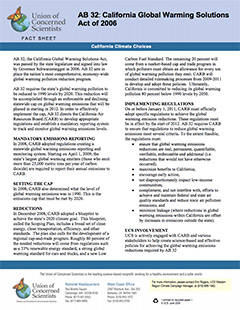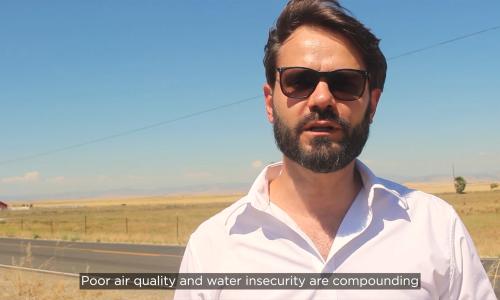The more global warming emissions are reduced, the less severe the impacts will be.
California has a choice: continue contributing to an alarming rate of global warming by emitting large quantities of global warming pollutants from its cars, electricity plants, and factories, or lead the nation and the world in slowing global warming by making significant cuts in emissions.
How much would global warming emissions have to be reduced to ensure that we stay in or below the lower warming range?
If the industrialized world were to follow California’s lead of reducing emissions 80 percent below 1990 levels by 2050 and the industrializing nations followed thereafter, global emissions would remain in or below the lower emissions scenario, thus increasing the likelihood that California and the world would be on track to avoid the more severe impacts.
California’s responsibility to act
California is the 12th largest source of global warming emissions in the world, exceeding most entire countries. California has a responsibility to reduce its global warming emissions, and by doing so can lead the United States, and the world, in developing the innovative policies and technologies needed to avoid the most dangerous impacts of global warming. Two independent teams of the state’s top economists calculate that significantly reducing global warming emissions can boost the state’s economy by billions of dollars and create tens of thousands of jobs in the coming decades.
Global warming emission reduction targets
In June 2005 Governor Schwarzenegger signed an Executive Order committing the state to the following targets for reducing global warming emissions:
- By 2010, California emissions will be reduced to 2000 levels, or by 11 percent
- By 2020, California emissions will be reduced to 1990 levels, or by 25 percent
- By 2050, California emissions will be reduced to 80 percent below 1990 levels
In 2006, the California legislature passed, and Governor Schwarzenegger signed, AB 32--the California Global Warming Solutions Act. AB 32 sets in place the
nation’s most comprehensive, economy-wide global warming emissions reduction program. AB 32 requires the state’s global warming emissions to be reduced to 1990 levels by 2020. This reduction will be accomplished through an enforceable statewide cap on global warming emissions that will be phased in starting in 2012.
Policy recommendations for 2008
A strong, enforceable cap on global warming emissions will be needed to achieve the reductions needed to meet the state's 2020 and 2050 goals. Sector-specific regulatory programs offer important opportunities for reducing emissions as well. Implementing aggressive renewable energy and energy efficiency policies for all electric providers in the state is essential. As the transportation sector will continue to be the largest source of global warming emissions in California for the foreseeable future, additional measures will be needed beyond the landmark emissions standards for vehicles now in place. For example, a self-financing program of emission-based discounts and surcharges on new cars will help consumers and families purchase cleaner new cars and encourage auto manufacturers to offer cleaner, more efficient cars to California drivers.




